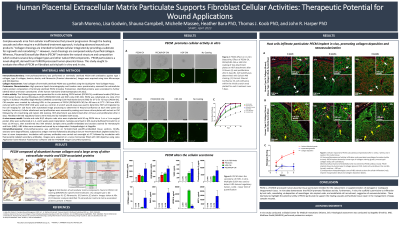Laboratory Research
(LR-036) Human Placental Extracellular Matrix Particulate Supports Fibroblast Cellular Activities: Therapeutic Potential for Wound Applications
Friday, April 28, 2023
7:15 PM - 8:30 PM East Coast USA Time

Lisa Godwin, .; Shauna Campbell, BS; Michelle Massee, MS; Heather Bara, PhD; Thomas Koob, PhD; John Harper, PhD
Introduction: Complex wounds arise from cellular insufficiencies that prevent progression through the healing cascade and often require a multifaceted treatment approach, including advanced wound care products.1 Collagen dressings are intended to facilitate cellular integration by providing a substrate for ingrowth and remodeling.2,3 However, most dressings are composed solely of purified collagen. Whereas, Placental Extracellular Matrix (PECM*) maintains the natural structure and composition which contains several key collagen types and other native ECM components. PECM particulate is a novel allograft, derived from PURION processed human placental tissue. This study sought to evaluate the effect of PECM on fibroblast activity both in vitro and in vivo.
Methods: PECM was characterized through a variety of histological, biochemical and proteomic methods. The effect of PECM extract (PECM-EX), containing soluble factors, on human dermal fibroblast (HDF) attachment, proliferation, migration and biosynthesis were evaluated. Conditioned media (CM) from PECM-treated HDFs (PECM/HDF-CM) and HDFs only (HDF-CM) were evaluated for downstream effects on cellular migration, as modeled by a scratch wound assay, cellular attachment, as well as protein secretion, as measured by multiplex ELISA assays. Athymic nude mice were implanted with PECM and evaluated at 1, 2, and 4 week endpoints. Implant sites were collected and evaluated by standard and immunofluorescent histological methods.
Results: The PECM particulate contains an array of matrix macromolecules and other regulatory proteins. Coating non-tissue culture-treated plates with PECM-EX or PECM/HDF-CM supported the attachment and growth of anchorage dependent fibroblasts. Additionally, PECM/HDF-CM enhanced the migration of HDFs compared to negative controls and contained elevated levels of fibroblast-derived regulatory factors. In vivo, mesenchymal cell infiltration into the voids of the particulate implant from the surrounding dermis was evident. Remodeling of the PECM particulate implant was observed at later time points with deposition of neocollagen and endothelial cell recruitment into the implant area.
Discussion: PECM is a PURION processed human placental tissue particulate intended for the replacement or supplementation of damaged or inadequate integumental tissue. In vitro data demonstrate that PECM promotes fibroblast activity. Furthermore, in vivo, the scaffold is permissive to infiltration by host cells, remodeling via deposition of neocollagen into implant voids, and endothelial cell recruitment, suggestive of neovascularization. These key features highlight the potential utility of PECM particulate to support the healing cascade and facilitate tissue repair in the management of large, complex wounds.
Methods: PECM was characterized through a variety of histological, biochemical and proteomic methods. The effect of PECM extract (PECM-EX), containing soluble factors, on human dermal fibroblast (HDF) attachment, proliferation, migration and biosynthesis were evaluated. Conditioned media (CM) from PECM-treated HDFs (PECM/HDF-CM) and HDFs only (HDF-CM) were evaluated for downstream effects on cellular migration, as modeled by a scratch wound assay, cellular attachment, as well as protein secretion, as measured by multiplex ELISA assays. Athymic nude mice were implanted with PECM and evaluated at 1, 2, and 4 week endpoints. Implant sites were collected and evaluated by standard and immunofluorescent histological methods.
Results: The PECM particulate contains an array of matrix macromolecules and other regulatory proteins. Coating non-tissue culture-treated plates with PECM-EX or PECM/HDF-CM supported the attachment and growth of anchorage dependent fibroblasts. Additionally, PECM/HDF-CM enhanced the migration of HDFs compared to negative controls and contained elevated levels of fibroblast-derived regulatory factors. In vivo, mesenchymal cell infiltration into the voids of the particulate implant from the surrounding dermis was evident. Remodeling of the PECM particulate implant was observed at later time points with deposition of neocollagen and endothelial cell recruitment into the implant area.
Discussion: PECM is a PURION processed human placental tissue particulate intended for the replacement or supplementation of damaged or inadequate integumental tissue. In vitro data demonstrate that PECM promotes fibroblast activity. Furthermore, in vivo, the scaffold is permissive to infiltration by host cells, remodeling via deposition of neocollagen into implant voids, and endothelial cell recruitment, suggestive of neovascularization. These key features highlight the potential utility of PECM particulate to support the healing cascade and facilitate tissue repair in the management of large, complex wounds.

.png)